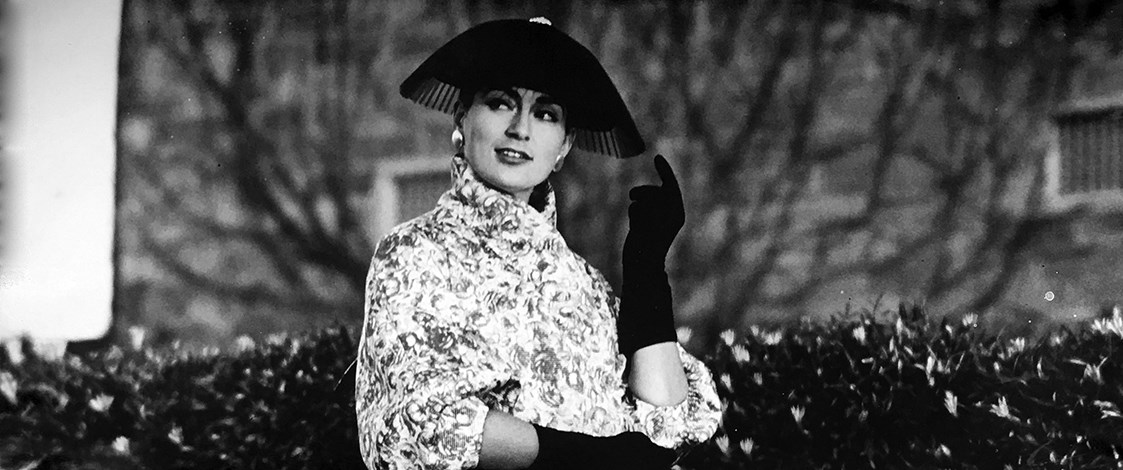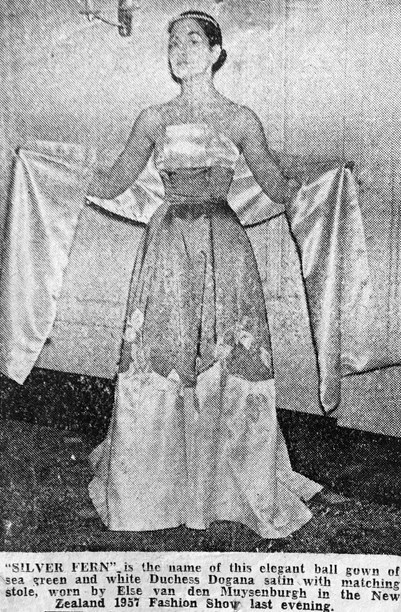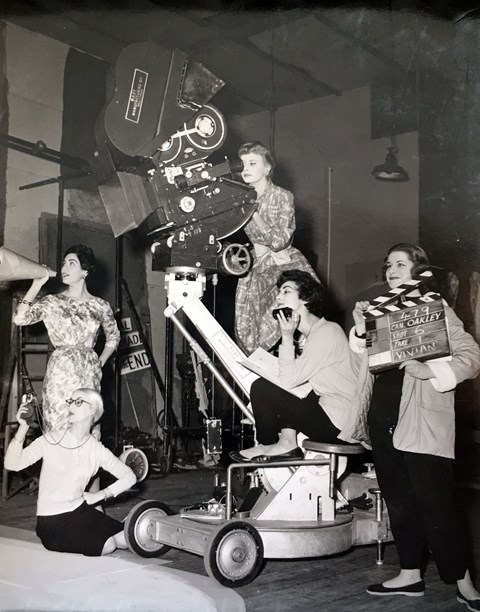Stories
Else van den Muysenbergh

Else van den Muysenbergh still maintains the aura of assured elegance that kept her modelling diary full at the peak of her career as one of New Zealand’s most successful fashion models.
Now in her 80s, Else is still slim, her thick well-styled hair lightened over the decades from the raven black of her younger days. Her green eyes light up as she talks about her modelling career.
"That must have been when I had a 19-inch waist," she laughs, looking at a glamorous image of her younger self as she leafs through her collection of press clippings and photographs that document her career highlights from the 1950s and early 1960s.
"Tall, 5ft, 8in., Else’s lovely figure especially shows sports clothes off to advantage," wrote one fashion commentator. Another described her as, "A Netherlander who prefers sophisticated clothes such as evening gowns."
Else arrived in New Zealand from the Netherlands in 1952 from her home town of Maastricht, where she’d achieved local fame as a swimmer. She and her brother Gouke Leek had finished their studies and were up for an adventure. Along with her fiancé, Walter van den Muysenbergh (also spelt Muijsenbergh), they sailed for Auckland on the SS Sibajak. Designer Rosemarie Muller, who became a lifelong friend, was on the same voyage. Some time later Else’s parents joined them. They became part of a group of creative Dutch immigrants who established homes in Auckland’s bush suburb of Titirangi.
For a while, fashion was a family affair. Else’s mother, Berber, worked as a hand finisher for Rosemarie who had set up her home design studio. Brother Robert Leek arrived in 1957 and enjoyed a successful design career, particularly in menswear, before becoming an academic. Both Robert and Else modelled beachwear for their friends, textile designers Frank and Carla Carpay. They were photographed by another of their friends, Ted Mahieu, who wanted to become a fashion photographer.
Ted Mahieu photographed Else during the early 1950s. Images © Ted Mahieu.
Else’s entry into modelling was accidental. Not long after her arrival she agreed to model for a fashion parade held by the St Helier’s Bay Plunket Society.
"I’d never even thought of modelling at the time," she says. "Afterwards the guy from Milne & Choyce came up and asked if I could do that season for them. I said, 'I can’t. I’ve never done it before!'"
She obviously re-considered the offer and hastily joined classes in Auckland run by an Australian model, midway through the course. From there she never looked back. "I never ever had to ask for a job," she recalls with a hint of pride.
Else’s arrival on the 1950s fashion scene coincided with the heyday of the department store fashion parade. The promotion of women’s clothing defined the stores’ public image. Mannequins, as models were then known, showcased seasonal ranges for the major stores. In Auckland, Milne & Choyce’s parades were legendary and other stores such as Smith & Caughey's, George Courts, John Courts and Rendells also held regular seasonal parades.

Else van den Muysenbergh (4th from left) during a parade with other models including Josephine Brodie (2nd from left).
House modelling was another option. As well as Rosemarie Muller, Else modelled for other luminary designers such as Colin Cole, Babs Radon and Emma Knuckey. Twice a year she would travel to Christchurch with Gus Fisher (who had the El Jay label and the New Zealand licence to make Christian Dior and whom she recalls as fussing over last-minute details), and Rosemarie Muller, to model in parades there.
During peak seasons life could be exhausting. As well as shows day and evening shows there were rehearsals for upcoming parades. Sometimes Else would do as many as 35 parades a week. Then on the bus ride home to Titirangi she felt she couldn’t take off her shoes to ease her aching feet. By then she had achieved a certain celebrity, even if she did have to catch the bus home.
One of many career highlights for Else was the 'Italy at Milne & Choyce' in 1955 when four Italian 'mannequins' were joined for parades in Auckland and Hamilton by selected local ones. It was a show of original Italian fashions from the 9th Florence Fashion Festival held in the Pitti Palace, and valued at £25 000. They were: "Fashions that reflect the artistry which won for post-war Italian designers a place of honour beside the leading couturiers of Paris, London and New York." Designers included Simonetta, Veneziani and Volpe of Rome. It created great excitement and one of the models whom Else liked very much, a philosophy student known as 'Lully', stayed on for a time as a house model for Emma Knuckey.
In 1957 the fashion press described Else as, "the most accomplished and experienced model in the country," noting her "smouldering beauty" at the inaugural New Zealand National Fashion Show. Sponsored by the New Zealand Textile and Garment Manufacturers’ Federation and launched in the Wellington Town Hall as Prelude to Spring, the show was compered by Paddy Walker and opened with a Māori welcome from model Mira Szazy (later Dame Mira).
In Auckland the New Zealand Herald noted the "poise, sure charm and unhurried dignity of the models … as they modelled sportswear, knitwear, suits, frocks with jackets, coats in featherweight fabrics – and the most spectacular 'after-five' section." Else’s big moment was modelling 'Silver Fern', an elegant ball gown of sea green and white Duchess Dogan satin with matching stole, from an (unknown) Dunedin designer. The travelling show was declared a "glittering success".

Else appeared in the newspaper in 1957 modelling Else’s big moment was modelling 'Silver Fern', an elegant ball gown and matching stole.
Behind the scenes was anything but glamorous. Else recalls dingy provincial motel rooms, and the girls having to barricade their doors in Invercargill when they discovered that a rugby team was staying in the same hotel.
Else paints a picture of camaraderie between the models; a group of rather wholesome girls who just wanted to have fun, for not very much pay. Many had 'second string' jobs as a 1959 Herald article outlines: "These girls have learnt the wisdom of having a secondary career. Even at the height of the season, one of New Zealand’s best known models, Else van den Muysenbergh, carries on with her second chosen job. 'Between 11 o’clock when a parade may stop and 2 o’clock when the second one starts, there is often nothing for many of the girls to do except drink coffee,' she said. But for some time now Else has helped out in one of the smart menswear shops in town, and in her spare hours on Friday nights becomes a most elegant saleswoman."
When she began working at the Shirt Centre in Queen’s Arcade, people would stop and stare at the sight of a woman working in a man’s shop.
Else also set up 'charm' schools in Auckland and in Wellington, driving her little Volkswagen to the capital and often combining teaching with modelling assignments there. Her three-week course included Basic Modelling Steps, Photographic Modelling, Deportment, Exercise for Figure Control, Diet, Fashion Sense, Hairstyling and Grooming, Facial make-up and Hostessing, for 6 guineas. The modelling course, offered to a limited number of applicants after a personal interview, was more expensive at 20 guineas.
It was with some regret that Else sold the schools after her second marriage to restauranteur and businessman, Otto Groen in 1964.
In 1958 she was part of a National Film Unit colour production on New Zealand fashion. A letter from the New Zealand Manufacturers Federation asked if she and her two fellow models could bring their own hats, bags and shoes, and described the featured colours as "navy, lavender, wheat and off white". All Else remembers is a lot of effort for a very fleeting on-screen appearance.

In 1958 Else was part of a National Film Unit colour production on New Zealand fashion.
Around the same time she was asked to assemble a fashion parade sponsored by the NZ Textile & Garment Manufacturers’ Federation for the Annual Conference of the Dominion Federation of Women’s Institutes. Up to 2000 women’s delegates were expected to gather in the Wellington Town Hall. Her instructions stated that: "The Models will include an OS matron supplied by the Women’s Institute." On the ensuing list of models and measurements Else’s slim 36-23-36 is followed by those of a Mrs Cotter, 44-37-45 – undoubtedly the OS matron.
In 1960 Else, at that time head of the Auckland Mannequins’ Association, bought herself a round-the-world air ticket and headed for the United States where she reported back to the local press that 'black' was the new fashion trend with all the models looking like Jacqueline Kennedy, the new President’s wife. She modelled in several European capitals and in Amsterdam worked for Dick Holthaus, hailed as the most successful Dutch fashion designer of his time. She also modelled for young designer, Frans Molenaar, and was featured as 'Top mannequin Else' in a cover story for a weekly Dutch magazine, Libelle.
"I used to write to my mother saying, 'I’m doing this show in a 17th century castle and we had champagne before we started and at least three times the money that I make in New Zealand.'"
Back in New Zealand subsequent assignments included the New Zealand Gown of the Year show, and in 1963, Else was chosen to model in a New Zealand Wool Board parade for Queen Elizabeth II.
Else continued with occasional modelling assignments up until the early 2000s.
Reflecting on the nature of her success, she can’t pinpoint what made her such an outstanding model. She’s never dieted, done particular exercises or even worn much makeup. "I was just natural, I think. I was lucky and as it turned out I absolutely loved it."
Text by Katherine Findlay. Banner image Else modelling for an Auckland Star fashion supplement. Image © Stuff / Auckland Star.
Last published January 2018